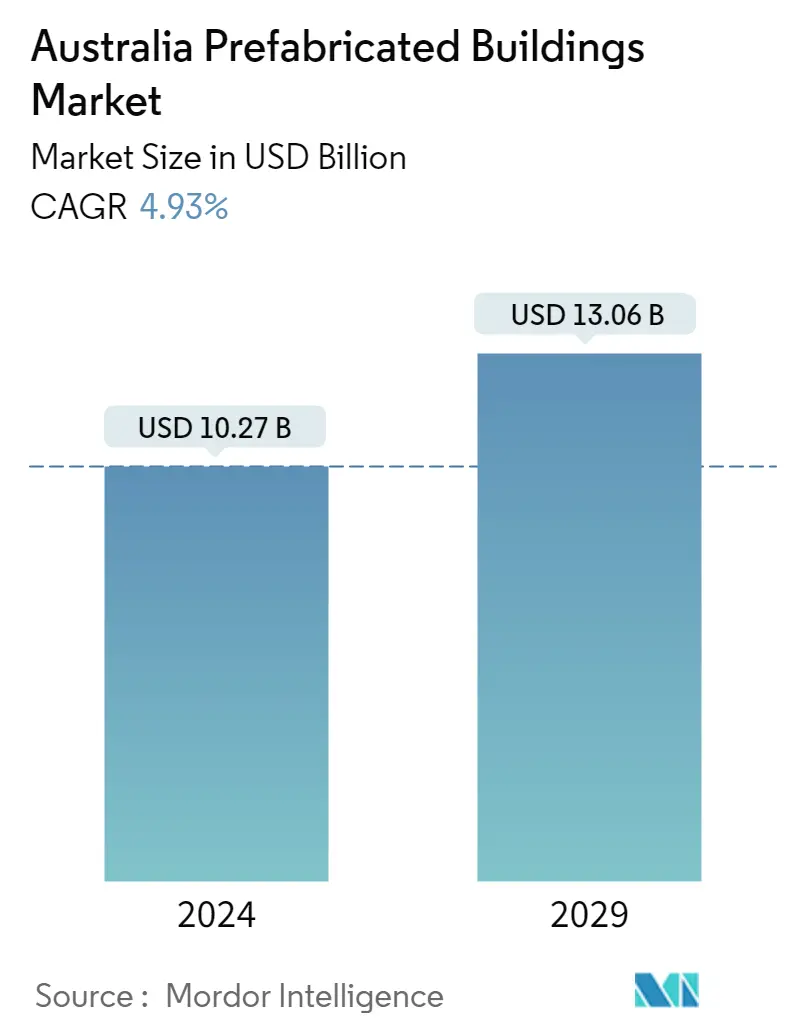Market Size of Australia Prefabricated Buildings Industry

| Study Period | 2020 - 2029 |
| Base Year For Estimation | 2023 |
| Market Size (2024) | USD 10.27 Billion |
| Market Size (2029) | USD 13.06 Billion |
| CAGR (2024 - 2029) | 4.93 % |
| Market Concentration | Low |
Major Players
*Disclaimer: Major Players sorted in no particular order |
Australia Prefabricated Buildings Market Analysis
The Australia Prefabricated Buildings Market size is estimated at USD 10.27 billion in 2024, and is expected to reach USD 13.06 billion by 2029, growing at a CAGR of 4.93% during the forecast period (2024-2029).
- The market is primarily driven by the demand for low to mid-rise residential buildings, project homes, and public housing. Increasing awareness about the benefits of prefabricated buildings, such as reduced material waste and less disruption to the surrounding environment, is driving market growth. Revenue in the prefabricated building industry is expected to grow as the rising demand from the government and education sectors has supported the industry during the COVID-19 pandemic. The Australian construction industry has faced severe challenges over the past two decades.
- The adoption of prefabricated solutions in Australia has increased significantly over the past few years. Industry associations and institutions in Australia are launching campaigns to create awareness about the benefits of the prefabricated industry. Leading figures in the Australian industry have recognized the productivity and efficiency gains that advanced manufacturing techniques can offer.
- Due to various causes, including a tight labor market, rising input costs, and increased demand due to government incentives, the construction and building industries have experienced significant price inflation in most states. However, the problems mentioned above are beginning to affect all types of construction. The cost rises traditionally started in residential construction.
- The construction industry has also seen significant delays in finishing projects due to labor shortages and a global supply deficit in several common building materials. The materials include steel, paint, cement, wood, cabinets, and electrical components. Compared to pre-pandemic levels, building material wait times have, at best, doubled and, at worst, increased by more than ten times. Construction projects will experience completion delays and increased cost pressure due to the unfavorable weather affecting the East Coast since the start of the year.
- The adoption of prefabricated solutions in Australia has increased significantly over the past few years. Industry associations and institutions in Australia are launching campaigns to create awareness about the benefits of the prefabricated industry. Many public spaces in Australia, such as new railway stations, police stations, healthcare facilities, and community centers, are now being built using volumetric modular construction and other prefabricated methods with the assistance of the Australian government. The prefabrication construction market in the country is estimated to witness growth.
Australia Prefabricated Buildings Industry Segmentation
Prefabrication is the practice of assembling components of a structure in a factory or other manufacturing site and transporting complete assemblies or sub-assemblies to the construction site. A comprehensive background analysis of the Australian Prefabricated Buildings Market, including the assessment of the economy and contribution of sectors in the economy, a market overview, market size estimation for key segments, emerging trends in the market segments, market dynamics and geographical trends, and COVID-19 impact, is covered in the report.
The Australian prefabricated buildings market is segmented by material type (concrete, glass, metal, timber, and other material types) and application (residential, commercial, and other applications (infrastructure and industrial)). The report offers market size and forecast values in (USD) for all the above segments.
| By Material Type | |
| Concrete | |
| Glass | |
| Metal | |
| Timber | |
| Other Material Types |
| By Application | |
| Residential | |
| Commercial | |
| Other Applications (Infrastructure and Industrial) |
Australia Prefabricated Buildings Market Size Summary
The modular construction industry in Australia is experiencing significant growth, driven by the increasing demand for sustainable and efficient building solutions. This sector is gaining traction due to its ability to reduce material waste and minimize environmental disruption, aligning with the growing public awareness of climate change. The Australian construction landscape is witnessing a shift towards prefabricated building methods, which involve assembling components off-site and transporting them to the construction location. This approach is particularly beneficial for low to mid-rise residential projects, public housing, and infrastructure developments such as railway stations and healthcare facilities. The government's support and incentives have further bolstered the adoption of modular construction techniques, making them a viable solution to address the challenges posed by labor shortages and rising material costs.
Despite the promising growth prospects, the Australian prefabricated buildings market faces challenges such as price inflation and project delays due to a tight labor market and global supply chain issues. The construction industry has seen significant increases in building material wait times, impacting project timelines and costs. However, the market remains competitive, with numerous global, regional, and local players vying for market share. Companies like Ausco Modular Construction Pty Ltd, Fleetwood Australia, and Archiblox Pty. Ltd. are key participants in this fragmented market. Initiatives like Queensland's QBuild MMC Housing Program highlight the potential of modern methods of construction to provide affordable and sustainable housing solutions. As the market continues to evolve, it presents ample opportunities for growth and innovation in the Australian construction sector.
Australia Prefabricated Buildings Market Size - Table of Contents
-
1. MARKET INSIGHTS
-
1.1 Current Market Scenario
-
1.2 Technological Trends in the Market
-
1.3 Insights on Supply Chain/Value Chain Analysis of the Market
-
1.4 Brief on Different Structures Used in the Prefabricated Buildings Industry
-
1.5 Cost Structure Analysis of the Prefabricated Buildings Industry
-
1.6 Impact of COVID-19 on the Market
-
-
2. MARKET SEGMENTATION
-
2.1 By Material Type
-
2.1.1 Concrete
-
2.1.2 Glass
-
2.1.3 Metal
-
2.1.4 Timber
-
2.1.5 Other Material Types
-
-
2.2 By Application
-
2.2.1 Residential
-
2.2.2 Commercial
-
2.2.3 Other Applications (Infrastructure and Industrial)
-
-
Australia Prefabricated Buildings Market Size FAQs
How big is the Australia Prefabricated Buildings Market?
The Australia Prefabricated Buildings Market size is expected to reach USD 10.27 billion in 2024 and grow at a CAGR of 4.93% to reach USD 13.06 billion by 2029.
What is the current Australia Prefabricated Buildings Market size?
In 2024, the Australia Prefabricated Buildings Market size is expected to reach USD 10.27 billion.

